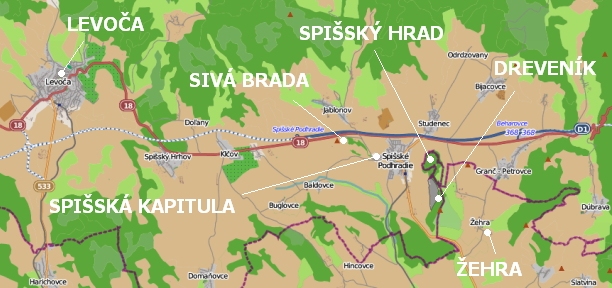Levoca
(Tourist Information Center, Namestie Majstra Pavla 4)
january – april OPEN 08:30 – 16:30 (saturday, sunnday CLOSED)
may – september OPEN DAILY 09:00 – 17:00
october – december OPEN 08:30 – 16:30 (saturday, sunnday CLOSED)
Marian hill
St. James Church
Slovak National Museum – Spis Museum
Museum of Special Pedagogy
Spis Castle

The Highest Gothic altar in the world carved by Master Pavol, quadrelingual Comeniusis Orbis Pictus, one of most common pilgrimage place of Slovakia „Marianska hora“ Marian hill and mysterious „White Lady – Júlia Göczy Korponay“ all those are immutable circumstancial evidence, which leads one to single spot of European map. Center of Spis region former Royal independent town Levoča – Leucha, Leutschovia, Leutschau, Lőcse…
Levoča was established in the 13th century and long periode of middle age belonged to prominent towns of Hungary. In the year 1494 Levoča had entertained one of the oldest summits, secret royal negotiation of Jagelons (Polish royal family). The raillway avioded the town, but a disadvantage of 20th century industry as well. That is the reason why Levoča lives in its meddieval atmosphere, to experience that feeling you should visit the town. Entering the towns gate,is as it was the gate of the time…
Where the appelation of town Levoča comes from? There were a lot of those who had beaten one’s brains. It was rumoured that since convocation Leut schau – people look! (german ligv. origin) – shout warming residents for Tatar approach, or old-German term Liuche – identical to fortified place… it is said. Truly it was and still is fortified and true is also that its development of the town had started after the Tatars invasion into the Hungary. The fear must have been a great one, reality is the evidence of 2,5km long walls, the covered erea of 41 ha, 3 entrance gates, 15 towers, 16 bastions and a enormous ditch.
The settelers coming into a depleted Hungary all people called Saxons. They must have been took by surprise, while their arrival into dense forest of Spis. Instead of deer feeding around, they discovered large medieval village of a aborigins of Slovak extraction. With use of biggest Romanesque church in todays Slovakia. Close around a settlement around rotunda of Holy Spirit and and another settlement of Flemish colonists from rich Burgundia. The distinction among all were very fast deflated. Gracious king Bel IV. granted residents with a lot of privilages. Expanding of the town walls were one of its results.
All at once Levoca had become centre of all province, suddenly the space around the walls was occupied more, population density started to grow, as well as desity of streets network, its residents have become more self-confident burgesses. The right of storage, the vanity of hungarian towns, limited liability of liberal market, those aspects multiplied all. Residents are bounded to first succesor to the throne of Anjou. Immense richnes had hoarded here.
They gratitude to fisrt from Anjou dynasty at the throne. An immense wealth had hoarded here. In between 40 guilds most significant were the goldsmith, the coppersmith, the tinsmith. The residents of Kežmarok obtained the right of storage by a trick. Royal Levoca could not bear that. Learnet people out of commons know, that a 100 years war wasn’t only between France and Endgland, but is situated also between Levoča and Kežmarok.
In the eyar 1550 almost whole town burnt. An important documents of towns archives burned to ashes deposited in wooden Townhall located in the middle of the town. This is the reason why people call the great carver of an altar Master Pavol not Pavol Sculptor or so, or for the time being more likely Pavol Schnitzer (german expression to name the carver). The records are irretrievably gone, maybe…But indissolubleness by flames its the spirit.
The Renaissance Levoča outgrow even more beautiful. The closing altar wings of highest Gothic altar of the world are still functioning, in spite of a lot of other fires or communist era. Ján Francisci and Pavol Dobšinsky (slovakian linguistic patriots) have had a another place for there meeting but they certainly had visited the churs several times. Evangelical seminary was located through the town scquare. Thousands of visitors are doing the same…

